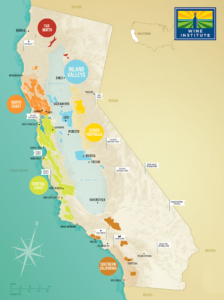Wine Institute Series Highlights the Wine Roads Less Traveled
SAN FRANCISCO — Wine Institute’s California Wine Country Back Roads series takes a look this month at the Inland Valleys, formed by the San Joaquin and Sacramento valleys, and also explores the Far North of the state. California is home to dozens of distinct wine regions, including some of the world’s most famous destinations. But hidden among even the high-profile appellations are the wine roads less traveled featuring stunning rural scenery, delicious wines and, often, fewer visitors. Discover new, off-the-beaten path wine roads and wineries this summer in these expansive, welcoming regions.
INLAND VALLEYS WINE REGION
Running 450 miles from the San Joaquin Valley in the south to the Sacramento Valley in the north, the Inland Valleys are located in California’s geographic center, one of the world’s most fertile agricultural regions. More than 230 crops are grown in this area—including a majority of the state’s winegrapes—plus almonds, apricots, tomatoes, cotton, asparagus, rice and more. Numerous wineries call the Inland Valleys home, the majority of which are small, family-owned producers. This means that winery visitors can usually find the winemaker or owner—often one and the same person—pouring in the tasting room.
TASTE: California’s capital city of Sacramento is surrounded by a diverse collection of wine regions and is also known as the state’s “farm-to-fork capital,” making it a popular home base for wine tasting in the Sacramento Valley. The Lodi wine region, just south of Sacramento, was named Wine Region of the Year by Wine Enthusiast Magazine in 2015. Winegrapes came to Lodi with the Gold Rush, and the local wine industry continued to flourish through Prohibition, thanks to farmers who maintained their vineyards for legal “home winemaking.”

Today, nearly 80 Lodi vintners craft some of the country’s finest Zinfandel from those same historic vines and also produce other red varietals, blends, rosés and whites from the more than 100 grapes grown in the region including Spanish, Portuguese, German, Italian and Southern Rhone varieties. Numerous wineries are easily reached from Highway 99, and a detour along Highway 12 to the east presents even more tasting options.
Nearby Clarksburg is famous for its Chenin Blanc, and the Old Sugar Mill—built in 1934 as a beet sugar refinery—now hosts 15 wineries that offer samples in a single space. Wineries in the Chico-Oroville area are in the northern reaches of Sacramento Valley. Find them on the North Sierra Wine Trail.
The San Joaquin Valley, south from Lodi, has been called “the food basket of the world,” producing asparagus, almonds, pistachios, oranges, peaches, garlic and—of course—winegrapes. More than 30 wineries call this region home, many accessible from State Route 180, producing a wide variety of wines that include Chardonnay, Zinfandel and Moscato.
Yosemite National Park is adjacent to the valley and just south of the park is Madera County, one of California’s oldest appellations. The region is known for its dessert and port-style wines, and there are plenty to sample along the Madera Wine Trail. Further south, explore the Fresno County Wine Journey with 13 wineries offering signature wines at each location.

Approaching California’s northern border is the majestic beauty of the Far North wine region with its giant redwoods and teeming wildlife. Residents of this area enjoy a quieter lifestyle, as evidenced by its rural homesteads and eclectic wineries. The scenic Shasta-Cascade region, which includes Mount Shasta and the Lassen Volcanic National Park, is home to more than 25 wineries. Humboldt County began growing grapes in the 1980s—many of them organic—and now there are more than 150 acres planted there.
TOUR: While visiting Sacramento, take a food-focused walking tour to meet some of the city’s most fascinating chefs, shop owners and local farmers with Local Roots Food Tours. The Madera Wine Trail hosts Red, White and Cool on July 6, a self-guided tour that features special wines at each stop and a California Wine Month celebration Sept. 20. While in the area, don’t miss stunning Yosemite National Park. Lodi’s Wine & Visitor Center, located on the picturesque grounds of the Wine & Roses Hotel, provides a great introduction to the region’s wines, with a rotating selection available for tasting each day. The Shasta-Cascades area is a haven for hikers, cyclists, bird-watchers, and anyone else who appreciates gorgeous scenery. Tour the slopes of Mount Shasta—a dormant volcano that peaks at nearly 15,000 feet, or visit Lassen Volcanic National Park, with its steaming fumaroles, clear mountain lakes and volcanoes. In Humboldt County, marvel at the magnificent redwoods or book an outdoor Adventure Tour.
For more information on lodging, dining and upcoming events, see Visit Lodi, Visit Sacramento, Fresno County Office of Tourism, Visit Mount Shasta and the Eureka-Humboldt Visitors Bureau.
For all of the wine regions included in this series, use the discovercaliforniawines.com interactive map to search wineries by amenities such as tours, gardens and picnic areas, and view winery events around the state.
To see Wine Institute’s Back Roads guides to other California wine regions, visit https://discovercaliforniawines.com/media-trade/news.
Wine Institute Communications Department, 415/356-7525
communications@nullwineinstitute.org

